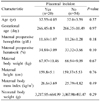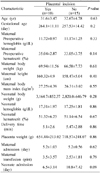Abstract
Objective
This study was to evaluate the safety of cesarean delivery through transplacental incision in anterior placenta previa and its effect on mother and neonate.
Methods
We examined 74 cases of placenta previa retrospectively who underwent cesarean section from May 2006 to December 2009, in Chungbuk National University Hospital. They were divided into two groups according to the placental incision. Transplacental incision was made in all cases of anterior placenta previa. We compared postoperative maternal hemoglobin change, neonatal hemoglobin and hematocrit, intra and/or postoperative transfusion volume, neonatal intensive care unit (NICU) admission days between the two groups.
Figures and Tables
References
1. Iyasu S, Saftlas AK, Rowley DL, Koonin LM, Lawson HW, Atrash HK. The epidemiology of placenta previa in the United States, 1979 through 1987. Am J Obstet Gynecol. 1993. 168:1424–1429.
2. Brenner WE, Edelman DA, Hendricks CH. Characteristics of patients with placenta previa and results of "expectant management". Am J Obstet Gynecol. 1978. 132:180–191.
3. Faiz AS, Ananth CV. Etiology and risk factors for placenta previa: an overview and meta-analysis of observational studies. J Matern Fetal Neonatal Med. 2003. 13:175–190.
4. Cunningham FG, Leveno KJ, Bloom SL, Hauth JC, Rouse DJ, Spong CY. Cunningham FG, Leveno KJ, Bloom SL, editors. Obstetrical hemorrhage. Williams Obstetrics. 2009. 23th ed. New York: McGraw Hill;757–803.
5. Ha JW, Chung IB, Cho HC, Lee HJ, Lee HJ, Han KH, et al. The comparison of the pregnancy outcomes according to the types of placenta previa. Korean J Obstet Gynecol. 2005. 48:51–57.
6. Park YS. Clincal analysis of placenta previa. Korean J Obstet Gynecol. 2003. 46:44–54.
7. Won HS, Lee PR, Lee IS, Kim A, Nam JH, Kim KJ, et al. Maternal and perinatal outcomes in pregnancies complicated with placenta previa totalis. Korean J Perinatol. 1998. 9:375–380.
8. Park CH, Hur EJ, Ko KS. A clinical study of placenta previa. Korean J Obstet Gynecol. 1996. 39:1439–1451.
9. Jung IS, Oh HY, Lee S, Lee JJ, Sung MS, Kim HC. A clinical study of the placenta previa. Korean J Perinatol. 1996. 7:289–295.
10. Han JY, Dong GJ, Kim JC, Bae KH. A clinical study of placenta previa. Korean J Obstet Gynecol. 1994. 37:1720–1727.
11. Wright FW. Placental localization by isotope scanning with 113m-In. Results in 200 patients. Br Med J. 1970. 2:636–639.
12. Kay HH, Spritzer CE. Preliminary experience with magnetic resonance imaging in patients with third-trimester bleeding. Obstet Gynecol. 1991. 78:424–429.
13. Oppenheimer L. Diagnosis and management of placenta previa. J Obstet Gynaecol Can. 2007. 29:261–273.
14. Ward CR. Avoiding an incision through the anterior previa at cesarean delivery. Obstet Gynecol. 2003. 102:552–554.
15. Ogawa M, Sato A, Yasuda K, Shimizu D, Hosoya N, Tanaka T. Cesarean section by transfundal approach for placenta previa percreta attached to anterior uterine wall in a woman with a previous repeat cesarean section: case report. Acta Obstet Gynecol Scand. 2004. 83:115–116.
16. Patterson LS, O'Connell CM, Baskett TF. Maternal and perinatal morbidity associated with classic and inverted T cesarean incisions. Obstet Gynecol. 2002. 100:633–637.
17. Greene RA, Fitzpatrick C, Turner MJ. What are the maternal implications of a classical caesarean section? J Obstet Gynaecol. 1998. 18:345–347.




 PDF
PDF ePub
ePub Citation
Citation Print
Print







 XML Download
XML Download